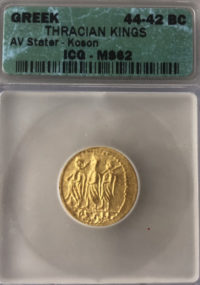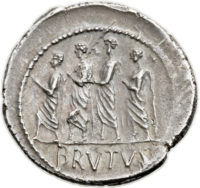 An anonymous donor dropped an ancient gold coin into a Salvation Army bucket in Florida on Friday morning. The gold stater from the 1st century B.C. was wrapped in one-dollar bill and dropped in the ubiquitous red kettle in front of a Publix grocery store in Tampa. A coin dealer estimated its market value at around $2,000.
An anonymous donor dropped an ancient gold coin into a Salvation Army bucket in Florida on Friday morning. The gold stater from the 1st century B.C. was wrapped in one-dollar bill and dropped in the ubiquitous red kettle in front of a Publix grocery store in Tampa. A coin dealer estimated its market value at around $2,000.
The obverse of the coin depicts three togate men, a Roman consul flanked by two fasces-bearing lictors. They are walking facing left. The word “ΚΟΣΩΝ” inscribed under them. The reverse has the image of an eagle standing on a scepter clutching a wreath in one claw.
The Independent Coin Graders label says it’s a “Greek Thracian Kings” coin dating to 44-42 B.C. but that’s a disputed identification. The coin was not minted in Greece. This type of stater has only been found in Transylvania, often in large hoards. Koson is believed to be name of the Dacian king who minted the coin, but his name and reign are otherwise unrecorded. Some scholars think he might be the same person as a king Cotiso or Cotison mentioned by historians Appian and Suetonius as having rejected Octavian’s offer of a marriage alliance and sided with Antony in the civil war and by the poet Horace as having been defeated in battle by Octavian.
Those events took place at 35 B.C., however, and the design of the coin suggests a connection to the previous generation of Roman civil warriors. The consul flanked by lictors is very similar to the reverse of a coin minted by Marcus Junius Brutus in his role as moneyer a decade before he assassinated his way into history. It depicts his ancestor, Lucius Junius Brutus, revered for having overthrown the last Tarquin king of Rome and considered the founder of the Roman Republic, as the first ever consul of  Rome in 509 B.C. It’s possible Koson modeled his stater after the 54 B.C. Brutus denarius as a tribute because he was a supporter of the latest Brutus to claim the status of liberator and tyrannicide. The 44-42 B.C. date would put it right in the middle of the wars after the assassination of Julius Caesar.
Rome in 509 B.C. It’s possible Koson modeled his stater after the 54 B.C. Brutus denarius as a tribute because he was a supporter of the latest Brutus to claim the status of liberator and tyrannicide. The 44-42 B.C. date would put it right in the middle of the wars after the assassination of Julius Caesar.
The Dacian kingdom had fallen apart in 44 B.C. and the territory was splintered into numerous conflicting tribal factions. If there was a Thracian king involved, he must have minted these coins specifically to pay Dacian tribesmen, perhaps for raids across the Danube.
The coin has been graded (MS-63), meaning it’s in mint, uncirculated condition with only minor deficiencies in the strike, not due to wear and tear. In this example you can see the obverse image is off-center, enough so that the beaded border is missing from the left side, as is the K in Koson. The Salvation Army is working with a dealer to arrange for the conversion of this coin into spendable cash for its charitable endeavors.
From ‘Paulys Realencyclopädie’, Vol. IV,2 on Dacia (machine translated excerpt). It is possible that Koson/ Cotiso has modeled not only his stater after Brutus :skull:
———-
“…After Burbista’s death, his empire disintegrated. At the beginning four, later five partial reigns (Strab. VII 304) took the place of the one and united Dacian empire. Although we must refrain from wanting to determine their extent and position, we encounter several names of Dacian kings in the time immediately after Burbista’s fall, which we are entitled to address as partial kings, as princes of partial reigns, since they appear simultaneously.
They are:
COTISO.[!] To Suet. Aug. 63 Antonius is said to have reported in his memoirs that Octavian had engaged his then five-year-old daughter Iulia to Cotiso and desired the daughter of the Dacan king as his wife. May there be something true about this story or not that Cotiso was a Dacian prince, we learn from Horace Ode II 8. 18 (occidit Daci Cotisonis agmen), which was written on 1 March of J. 29 BC. Also Florus (II 28) knows to report of a Cotiso, although the connection, in which he brings the same with the campaign of Lentulus, which surely takes place later, is obviously wrong. For Horace’s words suggest that Cotiso himself also perished, namely, as can be seen from the writing of the Ode, was already dead in J. 29. Des [1961] Florus words: Daci montibus inhaerent. inde Cotisonis regis imperio, quotiens concretus gelu Danuvius iunxerat ripas, decurrere solebant et vicina populari suggest the assumption that the Cotiso principality lay in Transylvania, not in the Theiss plain or in Walachia.
Dikomes. Immediately before the battle of Actium Canidius advised Antonius to give up the naval battle and march to Thrace or Macedonia to deliver a land battle: καὶ γὰρ Δικόμης ὁ Γετῶν βασιλεὺς ὑπισχνεῖτο πολλῇ στρατιᾷ βοηθήσειν (Plut. Ant. 63). Dikomes is called king of the getae here; but Cotiso is also soon called Dacer (Hor. od. II 8, 18. Flor. II 28), soon called Gete (Suet. Aug. 63), as these two popular names are so often used as synonyms at all. But the fact that Dikomes was Dacian in the narrower sense, i.e. belonged to the Transdanuvian tribe, illuminates to me, from Cass. Dio LI 22: οὗτοι οὖνοἱ μὲν Δακοὶ (these are, according to Dios’ explicit declaration, the inhabitants of the left bank of the Danube) ἐπρεσβεύσαντο μὲν πρὸ τοῦ χρόνου τούτου τούτου πρὸς τὸν Καίσαρα…
———-